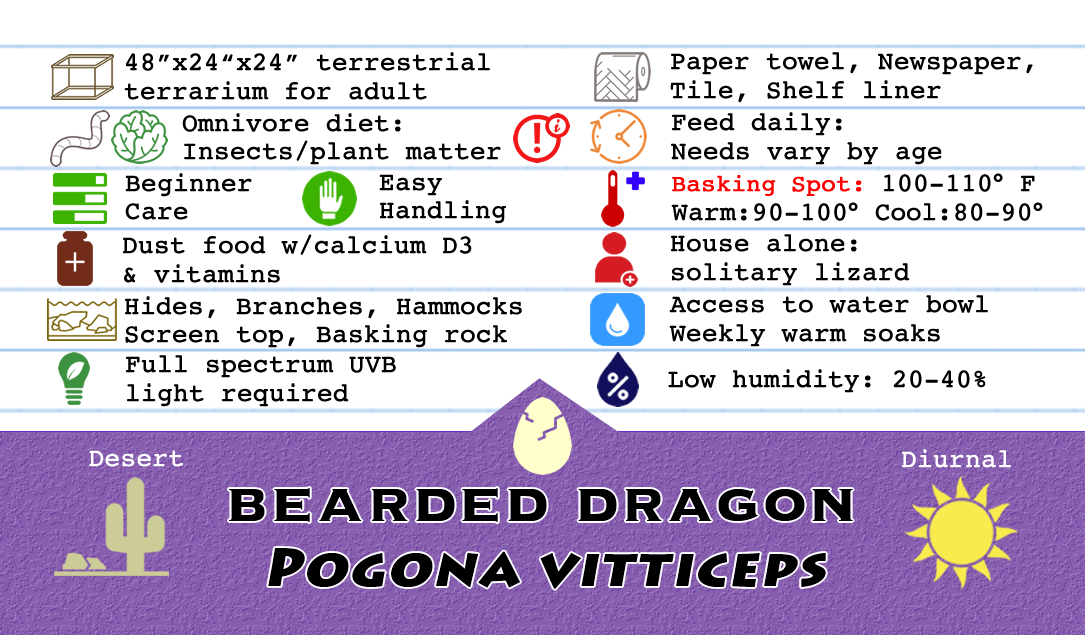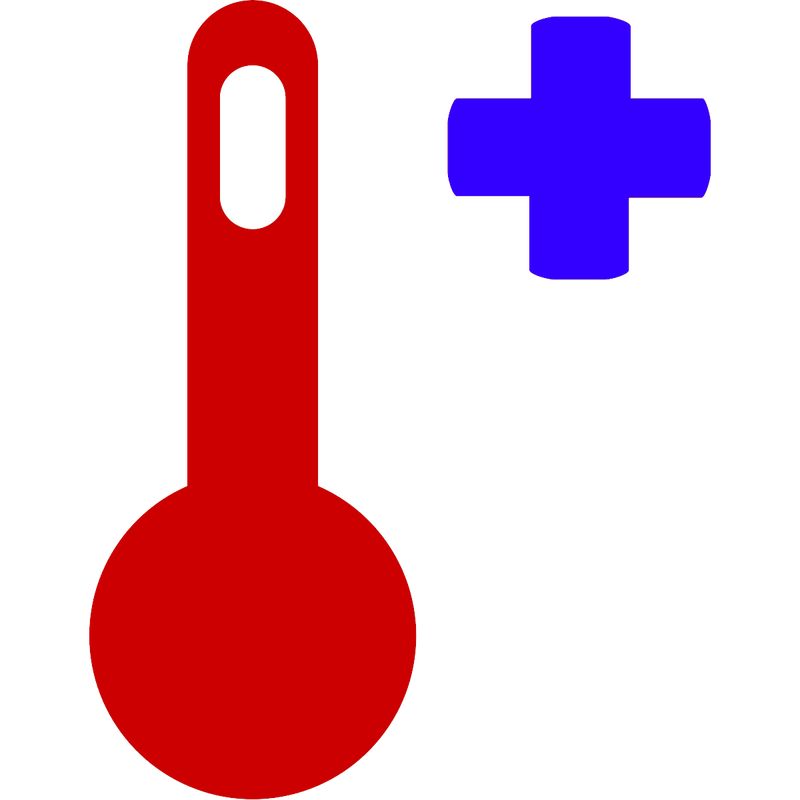Pogona vitticeps - Bearded Dragon
Bearded dragons are a medium, beginner lizard that come in a variety of morphs. They are a desert, terrestrial lizard and are diurnal, meaning they are active during the day. The are one of the best pet lizards available for their temperaments. They are omnivorous and eat both plants and insects.
|
Bring Home Your New Pet
When you bring your new dragon home, you should already have a quarantine tank set up and ready to go. Place fresh water in a bowl in the tank, mist the tank and offer food, but be aware it is completely normal for them to refuse food for the first couple days, or even longer. You should keep this new pet separate from any other pets you may have for 90 days, to ensure there is nothing it could spread to your other animals. Monitor its eating and fecals as they may be strange for up to a couple weeks, but this is due to a new diet, supplements, and environment. It is recommended you do not handle your new dragon for the first 24-48 hours and keeping it to a minimum until it has started eating on its own. Always keep in mind, your new animal is in a new tank, with new decor/dishes/hides, and new faces watching them. They need time to become acclimated to it all. After this quarantine process, they can be safely introduced to their permanent enclosure if it's not already. Be sure to wash your hands before handling any other pets during this time. |
|
Enclosure Bearded dragons need quite a bit of space as adults. Glass aquariums and terrariums are most common enclosures. Babies can be housed in 20-40 gallon tanks, but will need more space as they grow, so this is just temporary. Be sure to plan ahead and have space and funds to provide a bigger enclosure as they grow. Adult bearded dragons are active and do best in spacious accommodations. 75-120 gallons or larger is HIGHLY recommended (48”x24”x24”). Front opening enclosures are recommended as your dragon will feel threatened by being approached from above. We highly recommend Zen Habitats 4'x2'x2' Wood or PVC Panel Enclosure! |
|
Substrate
Loose substrates like sand are not recommended for bearded dragons. If you choose to use a loose substrate, please research further. Recommended, easy to clean substrates include newspaper or butcher paper, paper towels, reptile carpet or ceramic tile. Tile is easy to wash and disinfect when soiled and is visually appealing. Non-Adhesive shelf liner and linoleum can be used as well. |
|
Compatibility
Lizards by nature are solitary animals. Do not house a bearded dragon with another. They thrive best alone without the stress of competing with another animal in its space. It is recommended that each bearded dragon be housed alone to reduce stress, food aggression, dominance and fighting. |
|
Heating
Bearded dragons are cold blooded, so they rely on their environment to regulate body temperature. It is important that the temperature be between 95-100 degrees F on one side of the tank, while the other side of the tank be between 80-90 degrees so your dragon can thermoregulate by moving from one side of the tank to the other. Basking spots are vital to aid in digestion and regulate body temperature. Their basking spot should be 100-110 degrees. A deep dome light fixture with a high watt heat bulb is required. Place a large flat rock below the light for them to rest on and bask. Ceramic heat emitter bulbs provide heat without light and can be used to keep temperatures up in the winter months or cold nights, but a temperature dip at night is just fine. Place all lights on a timer. Dragons under 9 months need slightly higher basking temps at 110-115° F. DO NOT USE HEAT ROCKS. They are dangerous and can burn your dragon.
|
|
Lighting
Bearded Dragons require full spectrum lighting for 12-14 hours a day. Reptisun 10.0 T5 or T8 bulbs or Arcadia 12% tubes are known to provide some of the best full UVB for your dragons. Screen tops can filter some of this vital light, and the bulbs only last about 6 months before they need to be replaced as they become less efficient over time. If possible, your dragon should be able to get within 10-12" of the light to receive the best benefits. Having the correct type of UVB is important to the development of their bones and lack of UVB can have serious health effects. Be sure to have lights on a timer to offer a natural day and night lighting cycle. |
|
Humidity and Shedding
While bearded dragons are a desert species, they still need some humidity, especially during shedding times. Humidity levels should be between 20-40%. Bearded dragons can be soaked in a shallow bath of warm water, especially during shedding time. They will often poop in the bath and they can inflate themselves with air to float in the water, so do not be concerned if your dragon is suddenly full of air! |
|
Water
You can provide your bearded dragon with water in a bowl. Most dragons will not drink from standing water, but it I advised to have it available to them regardless. Reptile drippers are a good way to entice your dragon to drink by having the tube slowly drip into a bowl. Misting your dragon directly so they can lick the water droplets daily will help keep them hydrated, as well as weekly warm water soaks. You can also lightly mist their greens and vegetables for added moisture. |
|
Feeding Bearded dragons are omnivorous, meaning they eat both insects and plant matter. One of the most difficult part of owning a bearded dragon is understanding their dietary needs. This is a very basic guide - further research is recommended. Crickets, dubia roaches and hornworms are a great staple diet, with superworms, butterworms and waxworms as additional treat choices. Other great insect choices are lobster roaches, red runners, banana roaches, discoid roaches, locust, phoenix and silk worms. Be sure the insects you offer are no bigger than the space between your dragon's eyes. Insects should be dusted with calcium and vitamin powder at least 3 times a week. Be sure to remove uneaten insects. Feeding requirements change as your bearded dragon ages. Baby bearded dragons (hatchling to 5 months old) should be fed approximately 60% – 80% insects and 20% – 40% plant matter. Juvenile bearded dragons (5 months old to 18 months old) should be fed approximately 50% insect prey and 50% plant matter. Adult bearded dragons (over 18 months in age) require about 25% – 30% insect prey and about 70% – 75% plant matter in their diet. It is normal for young dragons to ignore their greens in favor of insects - keep offering it to them anyhow, eventually they will try them and eat them more. Feeding times change as well. Babies and juveniles need to eat multiple times a day. Raising a baby bearded dragon can be daunting! As they reach adulthood, insects can be offered 2-3 times a week with fresh greens and fruits available daily. A varied diet is important. Items in green can be fed as a staple. Items in orange should be offered as a treat. Items in purple or red are either not recommended or should be avoided completely. |
|
Handling
Bearded dragons are usually very docile and easy to handle. Babies can be quick, but by working with them and getting them used to being handled, they make wonderful pets as adults. They cannot climb well, so sitting on the floor and holding your dragon in your lap and letting them explore around you is the best way to handle them. Pick them up by supporting their entire body under your hands. |
|
Important Information
Bearded dragons, especially once they reach adulthood, may brumate during the colder months. Brumation is a form of hibernation. Your dragon may sleep for days and stop eating. This is completely normal, and there is nothing you can do to stop it. However, be sure to observe your dragon closely for signs of dehydration and other health issues. Improper temperatures, lighting and diet can also cause lethargy. If your care is correct and your dragon is slowing down, it is likely brumating. |
|
www.beardeddragoncare101.com is an excellent source for further, in depth research on bearded dragons! |































